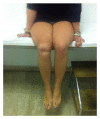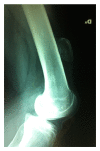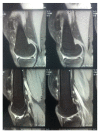Patellar Tendon Rupture after Lateral Release without Predisposing Systemic Disease or Steroid Use
- PMID: 25960904
- PMCID: PMC4413034
- DOI: 10.1155/2015/215796
Patellar Tendon Rupture after Lateral Release without Predisposing Systemic Disease or Steroid Use
Abstract
Arthroscopic technique for lateral release is the most widely used procedure for the correction of recurrent dislocations of the patella. In the relevant literature, several complications of lateral release are described, but the spontaneous patellar tendon rupture has never been suggested as a possible complication of this surgical procedure. Patellar tendon rupture is a rather infrequent and often unilateral lesion. Nevertheless, in case of systemic diseases (LES, rheumatoid arthritis, and chronic renal insufficiency) that can weaken collagen structures, bilateral patellar tendon ruptures are described. We report a case of a 24-year-old girl with spontaneous rupture of patellar tendon who, at the age of 16, underwent an arthroscopic lateral release for recurrent dislocation of the patella. This is the first case of described spontaneous patellar tendon rupture that occurred some years after an arthroscopic lateral release.
Figures




References
-
- Razzano C. D., Wilde A. H., Phalen G. S. Bilateral rupture of the infrapatellar tendon in rheumatoid arthritis. Clinical Orthopaedics & Related Research. 1973;91:158–161. - PubMed
-
- Zernicke R. F., Garhammer J., Jobe F. W. Human patellar tendon rupture: a kinetic analysis. The Journal of Bone & Joint Surgery—American Volume. 1977;59(2):179–183. - PubMed
-
- Nordin M., Frankel V. H. Biomechanics of the knee. In: Nordin M., Frankel V. H., editors. Basic Biomechanics of the Musculoskeletal System. 2nd. Philadelphia, Pa, USA: Lea & Febiger; 1989. pp. 115–134.
LinkOut - more resources
Full Text Sources
Other Literature Sources

